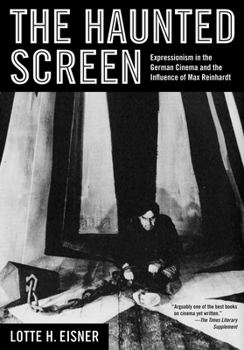The Haunted Screen: Expressionism in the German Cinema and the Influence of Max Reinhardt
Select Format
Select Condition 
Book Overview
The Golden Age of German cinema began at the end of the First World War and ended shortly after the coming of sound. From The Cabinet of Dr. Caligari onwards the principal films of this period were characterized by two influences: literary Expressionism, and the innovations of the theatre directors of this period, in particular Max Reinhardt. This book demonstrates the connection between German Romanticism and the cinema through Expressionist writings. It discusses the influence of the theatre: the handling of crowds; the use of different levels, and of selective lighting on a predominately dark stage; the reliance on formalized gesture; the innovation of the intimate theatre. Against this background the principal films of the period are examined in detail. The author explains the key critical concepts of the time, and surveys not only the work of the great directors, such as Fritz Lang and F. W. Murnau, but also the contribution of their writers, cameramen, and designers. As The Times Literary Supplement wrote, 'Mme. Eisner is first and foremost a film critic, and one of the best in the world. She has all the necessary gifts.' And it described the original French edition of this book as 'one of the very few classics of writing on the film and arguably the best book on the cinema yet written.'
Format:Paperback
Language:English
ISBN:0520257901
ISBN13:9780520257900
Release Date:September 2008
Publisher:University of California Press
Length:360 Pages
Weight:1.22 lbs.
Dimensions:1.0" x 5.9" x 8.1"
Related Subjects
Arts, Music & Photography Film & Television Humor & Entertainment Movies Performing ArtsCustomer Reviews
2 ratings
The white and the dark: spirit of german cinema
Published by Thriftbooks.com User , 24 years ago
In this work, Lotte Eisner makes an inteligent analysis about the influences of the expressionism and german theater - specially Max Reinhardt theater - in the german cinema. It's important to know that expressionism have been confused, not rarely, with other kind of ideological and esthetical sources of influence. And about this confusion, this book brings a good help. The authorress identifies and points what comes from the expressionism and what is not, where are the traces of the expressionism, of the german theater or whatever. And besides, Lotte Eisner speaks about the work of great german directors, like F. W. Murnau, F. Lang and G. W. Pabst, making an interesting and complete review of the german masterpieces - for example Caligari, Nosferatu and Metropolis, . She also speaks a little about other films related to Germany, yet made in other countries. Since the authoress was one of the most important movie critics of Germany, and also a wickness of the new birth of german cinema after the First World War, her statements or reviews are solid and plenty of good reveals.
White and dark: the spirit of german cinema
Published by Thriftbooks.com User , 24 years ago
In this work, Lotte Eisner makes an inteligent analysis about the influences of the expressionism and german theather in the german cinema. It's important to know that expressionism have been confused, not rarely, with other kind of ideological and esthetical sources of influence. And about this confusion, this book brings a good help. The authorress identifies and points what is expressionism and what is not, where are the traces of the expressionism, of the german theather or of whatever. And besides, Lotte Eisner makes an interesting and complete review of the most important german films, for example Caligari, Nosferatu and Metropolis, also speaking a little about other films related to Germany, yet made in other countries. Since the authoress was one of the most important movie critics of Germany, and also a wickness of the birth of german cinema after the First World War, her statements or reviews are solid and plenty of good reveals.






